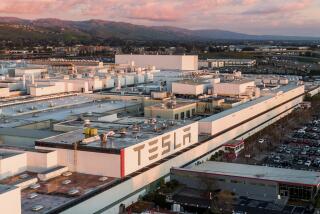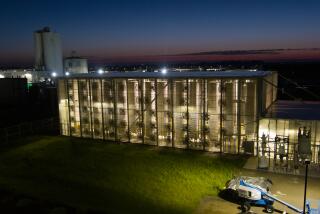Volvo Plans to Equip New Sedan With Ozone-Eating Technology
DETROIT — The Invasion of the Smog Eaters is about to debut.
No, it’s not the latest sci-fi flick from Hollywood. It’s the introduction of a low-cost automotive catalyst system that, when applied to a vehicle’s radiator, destroys ozone with which it comes in contact.
Volvo this spring will become the first auto maker to use the catalyst system, introducing it on the top-line 1999 S80 sedan. The Swedish auto maker plans to install smog-eating radiators in other models in the near future.
It is an unexpected revival for a technology given up for dead just two years ago. Ford Motor Co. rejected the smog-eating radiator in 1996 because the environmental effects appeared minuscule in road tests.
Questions still abound about the technology’s efficacy, but the California Air Resources Board is taking it so seriously that it may offer emissions credits to auto makers that equip cars with the ozone-zapping system.
The new technology was developed by Engelhard Corp., the Iselin, N.J.-based company that in 1976 created the three-way catalytic converter used on most cars today to reduce tailpipe emissions.
The latest advance involves applying a base-metal catalyst coating to a vehicle’s radiator. As air passes over the radiator, ozone is converted into oxygen, thus cleaning the atmosphere.
At ground level, ozone is the main component of smog and contributes to a number of respiratory maladies. Low-level ozone is produced when tailpipe emissions--hydrocarbons and nitrogen oxides--react in the presence of sunlight.
Volvo and Engelhard, which calls its catalyst system PremAir, say the technology destroys about 75% of the ozone that flows over the vehicle’s treated radiator.
While it is difficult to gauge the technology’s emissions impact, Engelhard and Volvo claim it can offset the hydrocarbons emitted by a clean-burning vehicle by 25% to 50%. The system should last 100,000 miles and cost less than $50, the companies say.
“It’s a relatively low-cost technology,” said Goran Wirmark, senior emissions engineer for Volvo, in a telephone interview from Goteborg, Sweden.
Volvo is introducing the new five-seat S80 sedan this fall but will not offer the smog-eating feature until next spring. Long known for safety features, Volvo hopes the new catalyst system will help it build a green image. It expects to sell about 100,000 S80s a year, including 25,000 in the United States, where the car will retail for about $40,000.
Engelhard, the world’s top auto catalyst maker with 1997 revenue of $3.6 billion, developed the smog-eating radiator from a system it uses to destroy ozone in passenger cabins of wide-body jets. A similar system is also being tested on stationary ozone-producing sources, such as air-conditioning units.
The company began promoting the auto-radiator system in 1995. At the time, Chief Executive Orin Smith said the technology had the potential to generate as much revenue as its traditional auto-catalyst business.
The statement pushed up Engelhard’s stock as well as the price of platinum, the precious metal then used in the catalyst coating. Euphoria also increased when Ford announced its test program in June 1996. The Securities and Exchange Commission later launched an investigation of eight Engelhard executives who sold stock during the price run-up. No charges were ever filed, and it could not be determined if the probe is still active.
Terry Bresnihan, a Ford spokesman, said the company declined to pursue the smog-eating technology because the environmental improvements were barely measurable.
“While the process worked in practical terms, our assessment was it would have negligible impact on the environment,” Bresnihan said, adding that he was unaware of any new developments that would cause Ford to change course.
Terry Poles, director of new ventures for Engelhard, argues that today’s cars have become so clean that new technologies that can provide small gains in net emissions are more important than ever.
Although the radiator technology is not the “silver bullet” that will solve the smog problem, he said, it’s another tool for auto makers to use in trimming overall emissions.
“There is no question it can offset a significant portion of the ozone from the tailpipe,” Poles said.
Engelhard is showing the smog-eating technology to other auto makers, which it declined to identify, and is hopeful they will follow Volvo’s lead.
The technology’s acceptance might well rest on regulatory action. Both the California Air Resources Board and the U.S. Environmental Protection Agency have shown interest in the technology. Next month, the California board is expected to decide whether auto makers can get hydrocarbon credits for using the smog-eating technology.
Environmentalists believe the ozone-destroying technology has some benefits, but more so in stationary rather than auto applications.
Roland Hwang, transportation program director for the Union of Concerned Scientists, said the technology has not been proved. There are questions of durability and how much ozone could be destroyed, he said.
He also questioned whether the regulatory focus should be on preventing pollution rather than its elimination once it is produced.
“It’s just the wrong way to go about pollution control,” he said.
Engelhard spokesman Sean Healy dismissed the complaints. The bottom line, he said, is that the smog-eating radiator works.
“It does destroy ozone,” Healy said. “It has enormous potential in the battle for clean air.”
Night Vision: Borrowing from military technology used during the Persian Gulf War, Cadillac will be the first auto maker to begin offering night-vision technology.
General Motors’ luxury brand said it will offer the night-vision system as an option on its 2000 model year DeVille, which goes on sale next year. The price was not disclosed but is expected to be about $2,000.
The system uses infrared technology and a head-up display that reflects an image on the lower portion of the windshield of objects that lie ahead but are not yet visible under normal circumstances.
The infrared system uses heat sensors that help drivers detect other vehicles, people or animals on or off the road, at night or in heavy fog, rain or snow.
“With night vision, Cadillac will bring Desert Storm technology into the family garage,” said Cadillac General Manager John Smith, who says night-vision systems are potentially as important for improving safety as anti-lock brakes and traction control.
Day Vision: Federal regulators want to dim the brightness of daytime running lights because of consumer complaints about glare in rearview mirrors.
The National Highway Traffic Safety Administration has proposed lowering the brightness limits on daytime running lights, which are meant to increase safety by making vehicles more conspicuous.
Canada requires all new vehicles to have daytime lights, and U.S. regulators have allowed them since 1993. General Motors is the only major U.S. maker that equips cars with daytime lights in this country.
U.S. regulators report that they have received 400 complaints about excessively bright daytime running lights. They are proposing to cut the maximum daytime brightness allowed to one-fourth the current limit over four years.
*
Donald W. Nauss is The Times’ Detroit bureau chief. He can be reached via e-mail at don.nauss@latimes.com.






